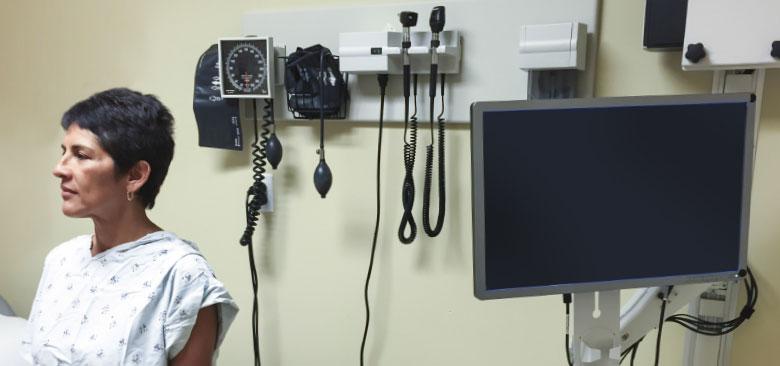
ANSIRH Celebrates 15 Years Spent Researching the Need for Reproductive Health Access
For the past 15 years, a collaborative research group, Advancing New Standards in Reproductive Health (ANSIRH), at the UC San Francisco Bixby Center for Global Reproductive Health, has sought to address issues surrounding sexual and reproductive health (SRH) by bringing rigorous research into the national discussion.
Founded in 2002 by UCSF researchers Felicia Stewart, a women’s health physician, and Tracy Weitz, a medical sociologist, ANSIRH (now headed by ob-gyn and School of Medicine faculty member Daniel Grossman) comprises a multidisciplinary team of 30 researchers, faculty and staff working on projects ranging from workforce issues and clinical and educational questions to cultural and socioeconomic factors that affect SRH. Since ANSIRH’s founding, researchers from the UCSF School of Nursing have had a prominent role, and today, a group of nurse-researchers are leading some of ANSIRH’s efforts to expand access to the full range of options for women with unwanted pregnancies.
 Daniel Grossman, Diana Taylor Nursing, a historically female-led profession, has been at the forefront of SRH advocacy from the beginning. “The ANA [American Nurses Association] was the first health professional organization to speak out as a pro-choice organization,” says Diana Taylor, associate professor emerita of Family Health Care Nursing, who served as the first senior nursing advisor to the group that would eventually become ANSIRH. She continues as an advisor to its projects on improving access to abortion care and expanding its workforce.
Daniel Grossman, Diana Taylor Nursing, a historically female-led profession, has been at the forefront of SRH advocacy from the beginning. “The ANA [American Nurses Association] was the first health professional organization to speak out as a pro-choice organization,” says Diana Taylor, associate professor emerita of Family Health Care Nursing, who served as the first senior nursing advisor to the group that would eventually become ANSIRH. She continues as an advisor to its projects on improving access to abortion care and expanding its workforce.
Bringing Comprehensive SRH to Primary Care
As advanced practice nursing has become increasingly important in primary care, the recognition that SRH is an essential component of primary health care has grown. Increasing the integration of SRH into primary care is one of ANSIRH’s chief goals.
“Our system is very fragmented,” says Taylor. “We tell a woman, ‘You’re pregnant,’ and if she doesn’t want to be, we tell her goodbye. Nowhere else do we have so little coordination of care.”
One of Taylor’s first projects for ANSIRH was to help develop its ongoing Primary Care Initiative, which seeks to expand access to early abortion care by translating evidence into both practice and policy that promotes the integration of SRH into primary care and public health. Taylor worked with researchers from other reproductive health organizations to develop a toolkit for nurse practitioners (NPs), certified nurse-midwives (CNMs) and physician assistants (PAs) who want to include abortion care in their practices.
The toolkit, which ANSIRH first published in collaboration with Provide and the National Abortion Federation, summarizes the evidence on the safety of abortion care provided by nurses and physician assistants. It also contains numerous tools to overcome barriers to integrating abortion care into women’s health care. The tools include resources for training and education, including an early abortion training workbook, a guideline for documenting competency and collaborative strategies for advancing scope of practice.
The Health Workforce Pilot Project
Taylor also served as co-primary investigator of the Primary Care Initiative/Health Workforce Pilot Project (PCI/HWPP). This California-based, multisite, six-year study addressed multiple aims: improving patient safety and provider effectiveness, enhancing abortion training standards and improving abortion care. It included the development of a framework to define and classify abortion-related incidents such as adverse events and morbidity.
With other ANSIRH researchers and faculty, Taylor helped analyze, translate and implement the PCI/HWPP study findings. This included evaluating a curriculum and training plan for primary care clinicians to develop competence in early aspiration abortion care, aimed at informing state legislators about the proposed value of this procedure. This work was instrumental in persuading the California legislature to pass a pair of bills in 2013, AB 980 and AB 154, which aimed to improve access to first-trimester abortion services for the state’s most vulnerable women. The bills’ passage has lifted the state’s previous restrictions on the facilities in which abortions are provided and allowed qualified NPs, CNMs and PAs who complete appropriate training to provide early aspiration abortion care.
Educators around the state also used these tools to train NPs, CNMs and PAs to provide early abortion care. ANSIRH then collected data and published a series of articles on outcomes, incidents and patient satisfaction with care from 19,673 early aspiration abortion procedures conducted by NPs, CNMs, PAs, medical residents and experienced physicians.
The research demonstrated that aspiration abortion-related incident rates were low overall, with 1.4 percent of all procedures resulting in an adverse event or morbidity; 96.7 percent of these incidents were classified as minor and resolved without further adverse outcomes. Moreover, it showed that medical and nurse trainees could develop competence in the procedure, and that early aspiration abortion care provided by NPs, CNMs and PAs was as safe as that provided by physicians. It also found that patients receiving care from both provider groups were very satisfied with their care, with a mean satisfaction rate of 9.4 on a scale of 0 to 10 (with 0 = completely unsatisfied, and 10 = completely satisfied).
A final version of the early abortion training curriculum guidelines integrates the newly revised Training in Early Abortion for Comprehensive Healthcare (TEACH) Early Abortion Training Workbook and training resources (2016) with the HWPP study findings and requirements in AB 154. The final version was developed by ANSIRH, the Bixby Center and the UCSF Department of Family and Community Medicine. ANSIRH’s research in this area has also provided support for change beyond California. In September 2017, the American Civil Liberties Union (ACLU), Planned Parenthood Federation of America and the ACLU of Maine used the research to support a lawsuit challenging Maine’s law prohibiting anyone other than a physician from providing abortion care.
Examining Nurses’ Roles in Unintended Pregnancy Prevention and Care
 Monica McLemore In the wake of the California legislation, Assistant Professor of Family Health Care Nursing and SRH advocate Monica McLemore is leading ANSIRH’s Nursing Practice Initiatives (NPI), a series of nursing-centered projects examining the roles and impact of the nursing workforce in SRH.
Monica McLemore In the wake of the California legislation, Assistant Professor of Family Health Care Nursing and SRH advocate Monica McLemore is leading ANSIRH’s Nursing Practice Initiatives (NPI), a series of nursing-centered projects examining the roles and impact of the nursing workforce in SRH.
McLemore and her ANSIRH colleagues are conducting research on best practices to inform education and guide nurses working in primary care. Increasingly, nurses are asked to provide SRH care within primary care, including prevention of and care during unintended pregnancy, particularly for low-income and underserved women.
Expanding Access to Medication Abortion
While the passage of the California legislation was an important step, there are still miles to go in improving access to comprehensive reproductive health, according to McLemore.
She and other ANSIRH researchers are looking to medication abortion as the next front in the battle. “We thought that when mifepristone [the so-called ‘abortion pill,’ also called RU-486] was approved for use in the U.S. in 2000, it would increase access to abortion, but immediately there were restrictions and laws passed to inhibit its potential reach,” she says.
Despite research that has demonstrated the safety of NPs, CNMs and PAs providing medication abortion services, laws in 36 states prohibit anyone but a physician from providing mifepristone. In addition, 19 states require the clinician providing it to be physically present when a patient takes it.
Such laws create significant hurdles for some women wanting early abortions, particularly those in rural areas with few physicians or health clinics.
Taylor bemoans this type of politicization of sexual and reproductive health. “It’s one of a few areas where clinicians have to get legal authorization to change practice to align with evidence.”
She, McLemore and their ANSIRH colleagues are working to engage both the public and nursing organizations in addressing political interference in SRH practice, education and research; Taylor co-authored the American Academy of Nursing’s recent position statement opposing “attempts by politicians and/or academic administrators to regulate instruction and research related to SRH based on ideology rather than principles of academic freedom and practice or education standards related to SRH.”
Getting Comprehensive SRH into College Health Centers
 Diane Tober Medical anthropologist and researcher Diane Tober, assistant professor in the Institute for Health & Aging, is collaborating with ANSIRH on a project to look at barriers to medical abortion access on California college campuses. The project is led by ANSIRH’s director, Daniel Grossman, in response to a proposed bill, SB 320, that would require state-funded universities with on-campus health care centers – including the University of California and the California State University system – to include coverage of medication abortion in their student health insurance plans and to provide access to medication abortion through their campus health centers.
Diane Tober Medical anthropologist and researcher Diane Tober, assistant professor in the Institute for Health & Aging, is collaborating with ANSIRH on a project to look at barriers to medical abortion access on California college campuses. The project is led by ANSIRH’s director, Daniel Grossman, in response to a proposed bill, SB 320, that would require state-funded universities with on-campus health care centers – including the University of California and the California State University system – to include coverage of medication abortion in their student health insurance plans and to provide access to medication abortion through their campus health centers.
While the safety and efficacy of medication abortion is well established, says Tober, the question of how to increase access for women on college campuses hasn’t been addressed. “This is something students want,” she says, “but there are a lot of challenges.”
To identify these challenges, Grossman, Tober and their colleagues at ANSIRH are conducting the necessary research to assess cross-campus needs and obstacles.
The challenges are likely to be different for different campuses, Tober says. “Some community colleges, for example, don’t even have a health center on campus. Some campuses may have a health center but no ultrasound machine [which may be needed to date pregnancies accurately]. We need to look at each campus and ask what they have and what they need.”
The bill has passed the California state senate’s Health Committee and is currently with the Education Committee. If it ultimately passes, the collaborative UCSF/ANSIRH research will inform the budget and plans for implementing services on campus.
“This is an exciting opportunity to draw upon substantive, collaborative research to inform policymaking,” says Tober.
Beyond Abortion Access
ANSIRH’s aim to build the evidence base surrounding reproductive and sexual health goes beyond expanding abortion access. A variety of projects are providing empirical evidence of the effects policies and attitudes surrounding SRH can have on people’s lives.
For example, ANSIRH’s researchers are examining issues as diverse as access to contraception, reproductive autonomy (women’s power to make decisions regarding childbearing), media depictions of abortion, and the mental and physical health and socioeconomic effects of having an abortion versus carrying an unintended pregnancy to term.
ANSIRH’s nurse-researchers are also committed to building a nursing workforce educated in and committed to SRH practice, education and research. Taylor has served as an important mentor to the current generation of nurse-advocates; she helped found the national grassroots organization Nursing Students for Sexual and Reproductive Health and Reproductive Health in Nursing (RhN), a collaborative aimed at building nursing capacity for providing SRH.
The vision, ultimately, is a world in which choices regarding sexual and reproductive health are supported by policies based on the best available science. As Taylor succinctly put it in an editorial in the Journal of Obstetric, Gynecologic & Neonatal Nursing: “Imagine a world in which every child is wanted and couples feel secure in making choices about when to have children and how many to have.”



